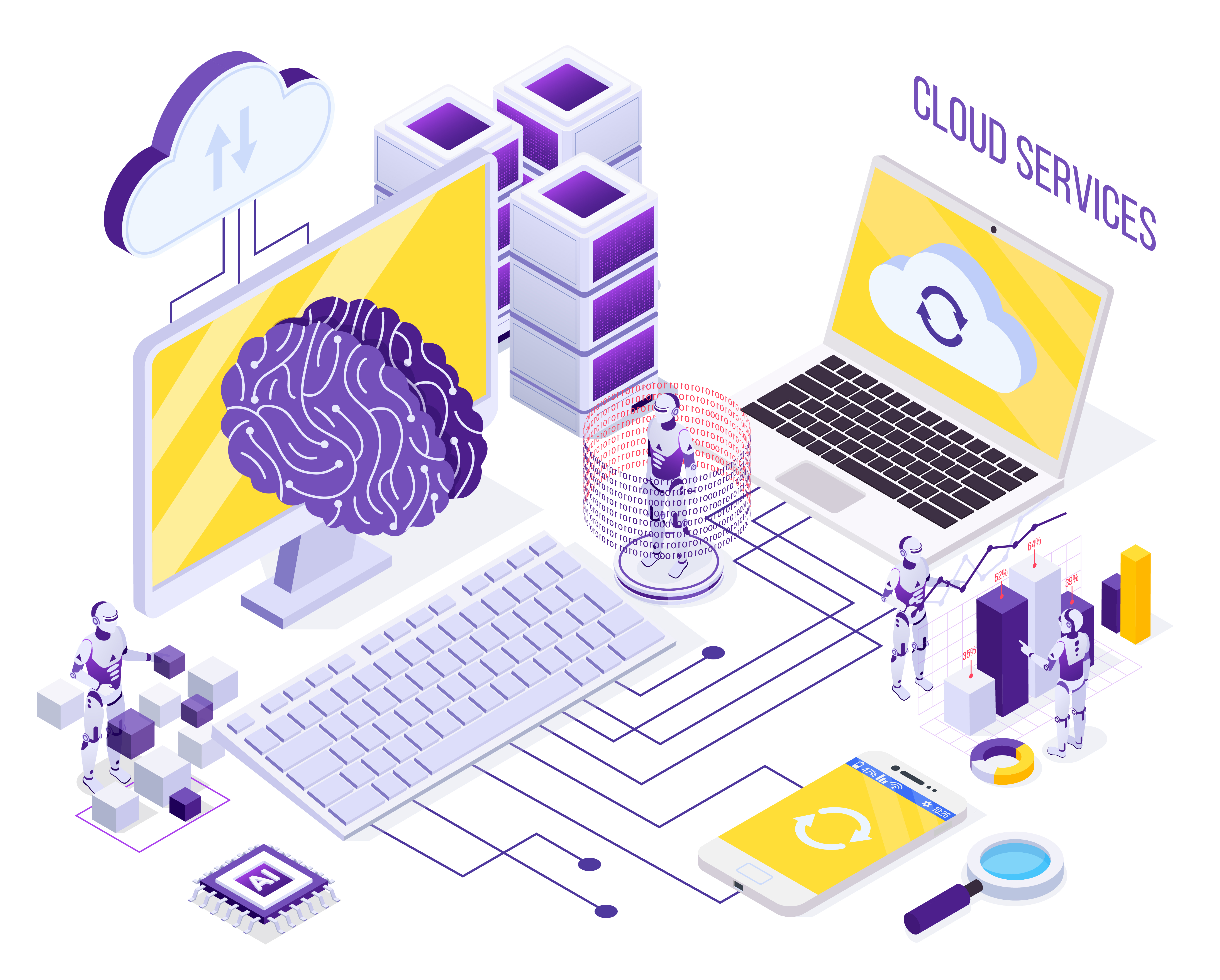Introduction
Cloud computing has changed how businesses handle data and applications. It allows firms to store, process, and access files across different locations. From software as a service (SaaS) to big data tools, cloud computing services now cover nearly every sector.
With machine learning and smart models, the experience has improved even more. The combination of AI and cloud is shaping the next phase of digital tools.
Cloud Computing Basics
Cloud platforms offer access to computing power, storage, and services. These include public, private, and hybrid setups. Each type of cloud computing serves specific needs.
A public cloud like Amazon Web Services (AWS) offers flexibility. Private clouds help meet strict rules. Hybrid models combine both.
The growth of these systems has led to more options. Now, firms can pick tools for almost any task. These tools also work well with AI. That adds extra support in making better choices and faster action.
Machine Learning in the Cloud
Machine learning works by training models on data sets. These models can sort, predict, or detect trends. With cloud computing, training happens faster. More storage and faster chips help build smarter tools.
Cloud platforms now offer machine learning tools built in. These are simple to use but very strong. Users upload a data set, set the rules, and the model starts learning.
Over time, the model improves. This is used in things like customer support, real-time alerts, and risk checks.
Read more: Cloud Computing and Computer Vision in Practice
Cloud Infrastructure with Smart Support
Data centers have become more advanced. Cooling, power use, and server load are now managed by software. AI runs checks to keep all systems in balance. If one part fails, it finds a fix or moves work elsewhere.
This helps prevent crashes. It also cuts costs by using less energy. Smart monitoring tools reduce waste and downtime. A well-run data center is key to strong cloud computing services.
Boosting Cloud Security
Cloud security has always been important. With smart systems, it’s now more effective. AI scans incoming traffic, looks for threats, and blocks attacks. It also runs checks on user behaviour.
For example, if a user logs in from a new device, the system may ask for more proof. This protects accounts without stopping work. Cloud vendors use these features to build trust and keep their users safe.
Real-Time Tools and Use Cases
Real time tools help firms react quickly. With cloud platforms, this becomes even more useful. Smart sensors track machines, sales, or users. The data goes to the cloud and is processed on the spot.
The system then acts or alerts users. Shops use this to update stock. Transport firms use it to track delays. In both cases, faster action improves results.
Data Analytics in Cloud Systems
Data analytics pulls useful facts from big data sets. AI helps this by finding trends or problems. Cloud computing offers the storage and speed to do this at scale.
Now, even small firms can run deep checks on data. They see what clients like, how supply chains behave, or where money is lost. These reports help them plan better. This is one of the biggest benefits of cloud computing today.
Read more: How Computer Vision and Cloud Computing Work Together
Major Cloud Vendors and Smart Tools
Large cloud vendors such as Amazon Web Services (AWS) and Microsoft Azure have built full toolkits. These toolkits help with storage, analysis, and computing. They also include machine learning tools.
For instance, Microsoft Azure lets users build and test models in a few clicks. AWS offers similar tools for deep data work. Many tools are shared across apps or regions. This helps large firms keep all data and applications running in sync.
SaaS with Smart Features
Software as a service (SaaS) means users access software via the web. It needs no download or local setup. When mixed with smart systems, it offers even more.
The software can adjust based on the user. It can predict what tool the user will need or offer suggestions.
In customer service, SaaS tools reply faster. In sales, they suggest deals. In health care, they spot risk faster. Each result saves time and improves support.
Types of Cloud Computing and Use
Each type of cloud computing fits different needs. Public clouds offer wide access. Private ones support rules and control. Hybrid types help firms mix the two.
This choice allows better use of budgets. It also helps meet legal and data rules. Some cloud vendors also help firms move between types without delays.
Read more: AI-Powered Video Surveillance for Incident Detection
Higher Level Functions
Smart tools let users focus on key tasks. They don’t waste time on setup or support. This higher level of work includes big data tasks, pattern search, or alert systems.
Users can build systems that work by themselves. These systems check data, act, and learn. They help staff spend time on big plans, not simple tasks.
Benefits of Cloud Computing and Smart Tools
The benefits of cloud computing go beyond low cost. It also offers wide access, fast scale, and strong security. When mixed with smart tools, the gains grow further.
Smart systems run checks all day. They learn from users and improve. They suggest better ways to do tasks. This brings down errors and boosts work speed.
Cloud Environments at Scale
A cloud environment can hold systems for many users. It can adjust when more users join. This helps during high demand. Systems add more space or power without delay.
With smart checks, the system knows when to act. It cuts waste and saves money. This scale is what sets cloud platforms apart from older tools.
Key Services Including Smart Tools
Many cloud services now include smart add-ons. These add-ons help with sorting files, checking words, or mapping user paths. Each helps users get better results.
Smart tools also adjust based on input. They learn which items matter. Over time, they improve. This adds value to all services including file checks, billing, or support.
Read more: Understanding the Tech Stack for Edge Computing
Cloud Vendors and Industry Support
Big cloud vendors now focus on smart upgrades. They add tools that sort, fix, or track items. These tools run without help. They cut costs and improve service.
AWS and Azure are two leaders in this space. They offer deep tools for many sectors. Each tool links to others. This allows full cloud platforms to grow as firms grow.
Data Centers with Smart Features
Modern data centers use less space but do more. Smart sensors track heat, power, and use. The systems change based on this input.
Firms save on power bills. They also avoid crashes. With smart models in place, these gains grow each year.
Real-Time Access and Smart Action
Real-time systems need fast action. Cloud setups allow this. Smart checks run as data flows in. They act if rules are met.
Firms use this for live support, alerts, or updates. In transport, this means fewer delays. In retail, it means better stock control. Smart action adds speed and value.
Cloud Infrastructure with Smart Links
Smart cloud infrastructure ties all parts of the system. This includes files, apps, and tools. Each part shares data and status. This improves results.
If one part slows down, others adjust. This keeps the system live. Smart links also help with growth. As needs rise, the system adds more tools.
Regulatory Implications and Strategic Adaptations
The integration of AI into cloud computing environments creates legal and regulatory pressure. Data residency laws are not consistent across borders.
Some require that sensitive information remains within certain jurisdictions. Cloud vendors must comply. This leads to strategic deployment of regional data centres.
A data centre in Frankfurt may serve only EU clients. A separate US facility will serve clients in the United States. These configurations affect architecture and affect cost.
Organisations using machine learning must assess the implications. Data fed into models might include personal or sensitive content. Laws such as GDPR and HIPAA require strict controls. Data classification, masking, and anonymisation techniques form the foundation of compliance.
Cloud platforms must offer integrated support. Microsoft Azure and Amazon Web Services provide such tooling, though depth varies.
Beyond legal concerns, ethical concerns exist. Bias in machine learning models leads to flawed decision-making. When biases go unchecked in a cloud environment, they scale rapidly. A poor model may affect hundreds of clients.
Quality assurance must occur before deployment. Fine-tuning, testing across demographic slices, and input audits must be part of standard practice. Cloud computing services now offer model validation tools to detect anomalies.

Evolving Ecosystems and Future Challenges
Machine learning in the cloud will evolve rapidly. Upcoming cloud infrastructure will accommodate models that require billions of parameters. This shift will require sustained advances in computing power.
Data centres will move from CPU-dominated configurations to GPU and TPU-dominant ones. Inference workloads will become the dominant cost driver. As inference complexity increases, clients will need to choose between accuracy and response latency.
Real-time requirements will strain cloud architecture. Industries such as finance, automotive, and medical imaging cannot afford slow responses. Cloud environments must balance performance against geography.
A high-frequency trading system in London cannot call a model hosted in Sydney. Edge computing becomes necessary. AI models trained in central facilities will deploy to edge nodes. These nodes act with partial autonomy.
In the enterprise domain, cloud security becomes critical. Data and applications, once centralised, are now scattered across hybrid clouds. An attacker who breaches a single node may extract entire data sets.
Services including encryption, identity management, and role-based access are no longer optional. Compliance auditors require them by default.
The proliferation of SaaS applications also introduces risks. Each software as a service instance acts as a potential ingress point. Poorly secured integrations allow data leakage. SaaS providers must audit endpoints, apply encryption at rest and in transit, and maintain detailed logs.
Cloud vendors are also entering the ML tools space. Beyond offering computing resources, they now provide machine learning platforms. These platforms include training, data analytics, model storage, and deployment. However, lock-in becomes a concern.
Moving from Amazon Web Services to Microsoft Azure requires reengineering. This barrier discourages competition. Firms must balance convenience with strategic independence.
Read more: Generative AI vs. Traditional Machine Learning
Industry Impacts and Case Structures
Different industries adopt AI-powered cloud computing in distinct ways. In manufacturing, real-time analysis of sensor data predicts equipment failure. Firms ingest large volumes from IoT networks into cloud analytics platforms. Patterns detected through machine learning models reduce downtime.
In e-commerce, data analytics helps identify purchasing trends. Retailers use these insights to adjust inventory and marketing. They employ recommendation engines based on previous user behaviour. These engines rely on training data updated in real time.
Healthcare presents high complexity. Patient records require strict protection. Yet, hospitals use machine learning to identify treatment outcomes. They train deep models on imaging data and electronic health records.
These models assist in diagnostics, but must operate under high accuracy thresholds. In such cases, real-time model updates are dangerous. Validation must occur offline.
Transportation firms use AI for route optimisation. Cloud infrastructure handles geospatial data, delivery schedules, and traffic updates. Algorithms update live routing tables.
Machine learning algorithms also detect fraud in ticketing systems. High throughput is essential. These platforms must maintain performance under load.
Education platforms use AI for adaptive testing. Questions adjust to user skill levels. Data collected from previous interactions informs item difficulty.
Machine learning systems track knowledge retention over time. The challenge here is ensuring equitable content delivery across demographics.
Energy providers use AI to balance loads. Grid data flows to cloud computing services. They model supply and demand curves, predict peak periods, and adjust grid inputs.
Mismatched models cause outages. Testing must simulate real conditions.
Across these industries, benefits of cloud computing are clear. But so are the responsibilities.
Operational Maturity and Strategic Posture
Firms using AI in the cloud must evolve operational practices. Traditional DevOps becomes MLOps. Pipelines extend beyond code deployment to include data validation, feature engineering, model retraining, and rollback mechanisms.
These new operational models require reskilling. Engineers must understand both software engineering and machine learning. System administrators must manage hybrid architectures.
Business analysts must understand metrics derived from model output. Cloud platforms assist with these transitions through managed services.
The choice of type of cloud computing—public, private, or hybrid—affects governance. Public clouds offer scale but raise data exposure risks. Private clouds offer control but require greater internal capacity.
Hybrid models allow selective distribution. Critical services operate internally. Non-sensitive workloads use third-party cloud vendors.
Monitoring becomes a core concern. Logs must capture data flow, transformation, and inference events. Real-time anomaly detection must trigger alerts. When a model produces outlier results, engineers must assess whether the cause lies in corrupted data, model drift, or security breaches.
Strategic decisions must factor cost. High compute instances, GPU reservations, and data egress charges can escalate. Cloud computing services price by usage, not value. Budget predictability becomes harder. Firms implement quotas, forecasting models, and cost dashboards.
In summary, adopting AI within cloud computing frameworks requires ongoing investment, not a one-time shift. Continuous learning, architectural flexibility, and operational discipline form the foundation of long-term success.
Read more: Artificial Intelligence (AI) vs. Machine Learning Explained
Benefits Across Sectors
Cloud tools support all types of firms. From banks to shops, smart systems make tasks faster.
In health, they check risks. In finance, they find fraud. In farming, they track crop needs.
Each case shows how cloud computing brings real gains. It makes work better, safer, and faster.
How TechnoLynx Can Help
TechnoLynx works with organisations looking to integrate cloud computing and machine learning. We design workflows that match business priorities. Whether you’re refining a cloud infrastructure or deploying deep learning models, we ensure each component meets security and performance benchmarks.
Our engineers help implement services including data analytics pipelines, real-time monitoring, and cloud security policies. We support deployments on cloud platforms such as Microsoft Azure and Amazon Web Services. Our teams optimise for computing power, scalability, and compliance.
If your enterprise handles sensitive data or requires hybrid setups, we help map regulations to design. With experience across sectors—from education to healthcare—we reduce the risk of poor deployment choices. Our cloud computing solutions improve operational maturity.
TechnoLynx ensures your architecture aligns with strategic goals. We manage training, assist with data centre integration, and enable your team to run ML workflows at a higher level. This provides measurable benefits and long-term flexibility.
Contact us now to start collaborating!
Image credits: MacroVector and Freepik













